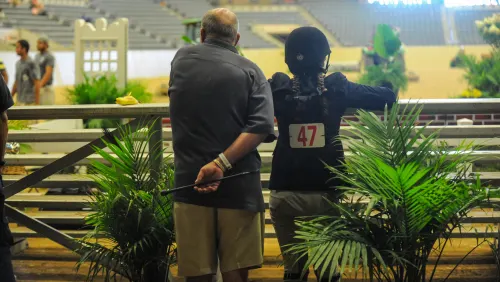 I can think of two moments that are almost guaranteed to draw sighs of affection and awe from knowledgeable horse people. One is the sight of a foal, especially a newborn, because–let’s face it–every foal is simply adorable. The other is the sight of the experienced and wise campaigner doing his job with that special combination of confidence, gusto and mastery. It’s that look of a horse who absolutely knows what he’s doing as he glides over a jumping course, makes smooth transitions to and from gaits or movements, follows hounds without cues from his rider, or just skips over a steeplechase course as if it’s no challenge at all.
I can think of two moments that are almost guaranteed to draw sighs of affection and awe from knowledgeable horse people. One is the sight of a foal, especially a newborn, because–let’s face it–every foal is simply adorable. The other is the sight of the experienced and wise campaigner doing his job with that special combination of confidence, gusto and mastery. It’s that look of a horse who absolutely knows what he’s doing as he glides over a jumping course, makes smooth transitions to and from gaits or movements, follows hounds without cues from his rider, or just skips over a steeplechase course as if it’s no challenge at all.
Why do these two opposite ends of equine life always elicit a fond smile? Because between them is almost always a whole lot of years and experiences, along with innumerable hours of sweat and toil and training. It’s the people who’ve been through that process, that transformation, time and again, who most cherish both sights, knowing what it’s like to turn the fresh grape of a foal into the perfectly aged wine of the astute campaigner. It’s usually a long and uncertain road, but worth the adventure.
Like a wine barrel, every foal is an open vessel, and the people who ride him and train him determine what gets poured into it. Of course, the horses don’t all start life equally. Some are more athletic, and different breeds are generally better suited to some sports than others (a halter-type Quarter Horse is an unlikely dressage prospect and a Holsteiner won’t be much use in racing). Plus, some are born more self-confident than others, some are more sensitive, some are more wary, and some are just plain smarter than others.
The trick to developing each horse is figuring out which ones you have to push, which ones you have to cajole, which ones you have to figuratively hold their hands, which ones you have to motivate, and which ones you just have to adjust to. And it’s not a one-time calculation, because, just like us, they’re not always exactly the same horse.
ADVERTISEMENT
It’s always enlightening, and usually rewarding, to watch your equine partners develop, to see that look in their eye change from uncertainty (even fear) or teenage defiance to confidence and understanding and willingness. They grow more mature, more confident, more able to understand the stimuli and distractions in the world around them, more accomplished at reacting to the increasing complexity of the challenges we present to them. It’s even fascinating to watch them develop physically too as they build muscles to gallop faster, jump higher, collect, extend, and to use their shoulders, backs and butts in dressage or jumping.
And when horses reach that grand state of being old and wise, they become something to really enjoy. They become horses that you can trust in any situation, whether competing or just riding around. On any day you might revel in their power, in the rapidity and trueness of their response to your aids. You might revel at their speed, power or fluidity over the jumps, or you could admire their courage and their stamina, which is part genetics and, if you’ve trained and developed this horse from a youngster, part your input.
I’ve often wondered why some riders won’t admit that they’ve retired a horse, especially one they’ve brought along and enjoyed. But I think it’s because they harbor a dream (one they can’t even admit) that someday, despite age or injuries, that horse will be back, allowing them to relive those moments, that wonderful feeling, all over again.














